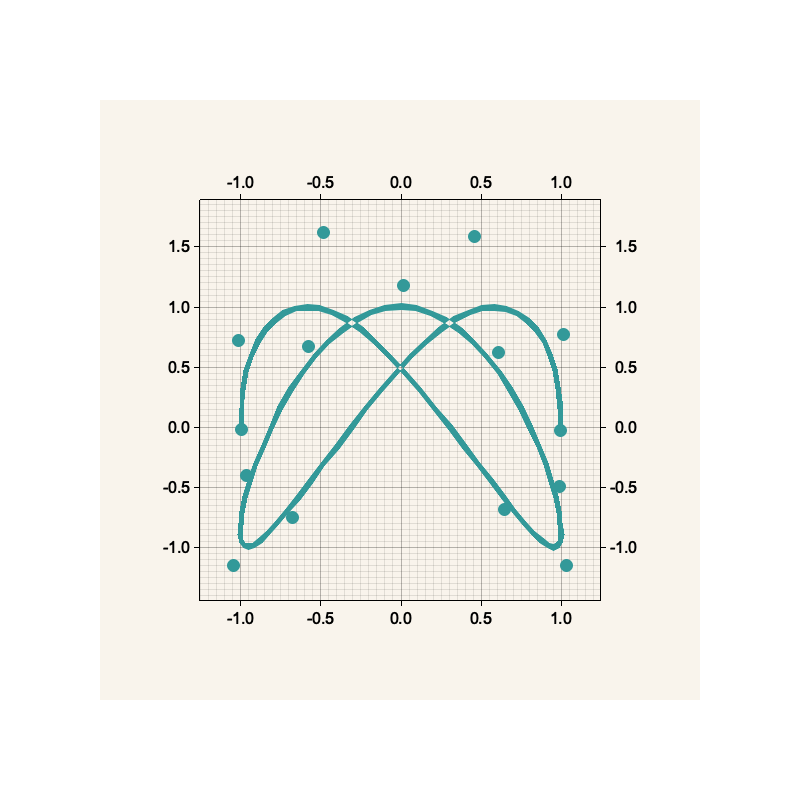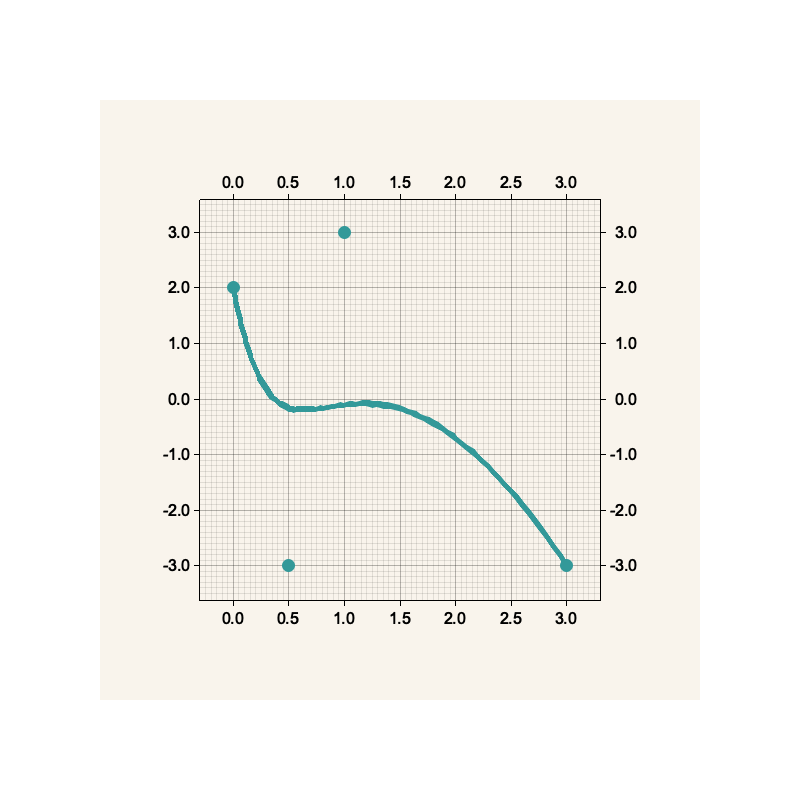
Spine curves are piecewise polynomial (parametric) curves, used for interpolation, curve fitting, and data smoothing.
Spliny is a (tiny) pure Rust library to use spline curves, based a spliny's knots and control points in SplineCurve<K,N>,
and to plot splines --currently limited to 1 and 2D splines-- to check the results.
It does not fit spline functions to data-sets: see the Splinify-crate for that purpose.
Get a spline curve for a Lissajous-dataset, with plot and JSON representation:

```rust use splinify::{CubicSplineFit2D, Result};
fn lissajous(t:f64, a: f64, kx: f64, b: f64, ky: f64) -> [f64;2] { [ a * (kx * t).cos(), b * (ky * t).sin() ] }
fn main() -> Result<()> {
// Generate Lissajous data points, with angle parameter `u`
// ranging from 0 to 180º, with 1º-steps.
let u: Vec<f64> = (0..=180u32).into_iter().map(|v|(v as f64).to_radians()).collect();
let xy: Vec<f64> = u.iter().flat_map(|t|lissajous(*t,1.0, 3.0, 1.0, 5.0)).collect();
// fit Cubic Spline with Splinify's CubicSplineFit
let s = CubicSplineFit2D::new(u, xy)?.smoothing_spline(5e-3)?;
// Output fit results as JSON file and plot
println!("{}", serde_json::to_string_pretty(&s)?);
s.plot_with_control_points("lissajous.png", (800,800))?;
Ok(())
} ```
And here is it's associated Spliny JSON representation
json
{
"t": [
0.0, 0.0, 0.0, 0.0, 0.4014257279586958, 0.7853981633974483,
0.9948376736367679, 1.1868238913561442, 1.3788101090755203,
1.5707963267948966, 1.7802358370342162, 1.9722220547535925,
2.1642082724729685, 2.356194490192345, 2.7576202181510405,
3.141592653589793, 3.141592653589793, 3.141592653589793,
3.141592653589793
],
"c": [
0.9961805460172887, 1.01581609212485, 0.45785551737300106,
-0.6743400479743561, -1.04606086926188, -0.9655723250526262,
-0.5757280827332156, 0.017487591989126007, 0.610401362313724,
0.9866605336566671, 1.0335232431543322, 0.6453772441164307,
-0.4846359310719992, -1.014195365951515, -0.9964502165043656,
-0.027374797128379907, 0.770580186441133, 1.5844468932141083,
-0.7504988105159386, -1.1533053154158592, -0.39940623356854926,
0.669953241001308, 1.1822672685309246, 0.6182210556297563,
-0.493261782484514, -1.1530136311265229, -0.6885569654105621,
1.6217843337199846, 0.7207977628265237, -0.02317389641793977
],
"k": 3,
"n": 2
}
Here a Cubic Spline is constructed from 4 control points:

```rust use spliny::{CubicSpline2D, Result};
pub fn main() -> Result<()> {
let spline = CubicSpline2D::new(
vec![1.0, 1.0, 1.0, 1.0, 2.0, 2.0, 2.0, 2.0],
vec![0.0, 0.5, 1.0, 3.0, 2.0, -3.0, 3.0, -3.0]
);
spline.plot_with_control_points("cubic2d.png", (800,800))?;
Ok(())
} ``` The control points are 4 control point: (0,2), (.5,-3), (1,3), and (3,-3), and the curve has 8 knots.
Spliny is developed as part of a family of three crates, but can be used independently too:
splinify fits (non-uniform) B-Spline curves to input data,
and results in a fitted as a spliny-crate CurveSpline.
Data inputs are x and y vectors for 1 dimensional curves,
and u and xyn vectors in case of N-dimensional curves.
Use spliny to to use the generated splines, for example to calculate curve coordinates, or a spline-curve's derivatives. This package also implements basic tools for input and output of spline representations in form of JSON files, and spline plots. It is completely written in Rust, and does not require a Fortran compiler.
dierckx-sys contains Fortran foreign function interfaces to Paul Dierckx' FITPACK library.
It is used by splinify, but ---unless you want to explore Paul Dierckx library yourself--- can be ignored as concerned to using splinify and spliny.
To use this library add this to your Cargo.toml file:
[dependencies]
spliny = "0.1"
The base spline representation in Spliny is the SplineCurve<K,N> object ---a wrapper for an vector of knots, and
fit coefficients--- with K the spline degree, N the space dimension of the curve spline.
For convenience, the following aliases have been defined:
| Alias | K | N |
|-----------------------|:-:|:-:|
| LinearSpline | 1 | 1 |
| CubicSpline | 3 | 1 |
| QuinticSpline | 5 | 1 |
| LinearSpline2D | 1 | 2 |
| CubicSpline2D | 3 | 2 |
| QuinticSpline2D | 5 | 2 |
| LinearSpline3D | 1 | 3 |
| CubicSpline3D | 3 | 3 |
| QuinticSpline3D | 5 | 3 |
All content ©2021 Harbers Bik LLC, and licensed under either of
at your option.
Unless you explicitly state otherwise, any contribution intentionally submitted for inclusion in the work by you, as defined in the Apache-2.0 license, shall be dual licensed as above, without any additional terms or conditions.